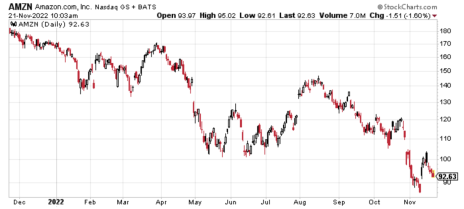Happy turkey week! Before we dive into one of my favorite options income strategies, I want to take a moment to paint a picture of the broad market. What a difference a year makes! At this time last year, the S&P 500 was trading for roughly 4,700, over 15% higher than where it is trading now and many household name stocks have followed the same path as the major market index … down, down, down.
“Whether we are talking about socks or stocks, I like buying quality merchandise when it is marked down.” – Warren Buffett.
Here is the year-to-date performance of a few high-quality companies that reside within the S&P 500:
· Netflix (NFLX) is down 52.2%
· Amazon (AMZN) is down 43.5%
· Intel (INTC) is down 42.0%
· Walt Disney (DIS) is down 40.7%
· Alphabet (GOOGL) is down 33.7%
· FedEx (FDX) is down 32.5%
· 3M Company (MMM) is down 28.6%
· Microsoft (MSFT) is down 28.3%
Bear markets are painful and well, inevitable. But as history shows time and time again, they are ultimately surmountable.
“A pessimist sees the difficulty in every opportunity; an optimist sees the opportunity in every difficulty.” – Winston Churchill
At the moment, I fall into the latter part of Churchill’s quote. Opportunities are prevalent, especially for those that employ options income strategies that rely on selling. The reason I state this is because with stocks like the ones listed above, I can choose to buy stocks 10% to 15% below where they are currently trading, giving me an even deeper discount … and receive a premium (income) for doing so.
[text_ad]
Options Income Strategies: The Wheel
The wheel options strategy is an inherently bullish, mechanical, options income strategy known by various names. The covered call wheel strategy, the income cycle, and the options wheel strategy are just a few of the many names that investors use. But one thing is certain: The systematic approach remains the same.
More and more investors are choosing to use the wheel options strategy over a buy-and-hold approach because it allows you to create a steady stream of income on stocks you want to or already own.
The mechanics are simple.
- Sell Cash-Secured Puts on a stock until you are assigned shares (100 shares for every put sold)
- Sell Covered Calls on the assigned stock until the shares are called away
- Repeat the Process!
Basically, find a highly liquid stock that you are bullish on and have no problem holding over the long term. Once you find a stock that you’re comfortable holding, sell out-of-the-money puts at a price where you don’t mind owning the stock.
Keep selling puts, collecting even more premium, until eventually you are assigned shares of the stock, again, at the strike price of your choice. Once you have shares of the stock in your possession begin the process of selling calls against your newly issued shares. Basically, you are just following a covered call strategy, collecting more and more premium, until the stock pushes above your call strike at expiration. Once that occurs, your stock will be called away, thereby locking in any capital gains, plus the credit you’ve collected.
Let’s go through an example on one of the stocks mentioned above to show you exactly how these options income strategies work.
Amazon (AMZN)
Wheel Options Strategy – Step One
AMZN is currently trading for 92.63.
Let’s say we are comfortable owning shares of Amazon approximately 15% below where the stock is currently trading.
As a result, we decide to sell puts at the 77 put strike, 16.3% below the current stock price.
We can sell to open the 77 puts for roughly $1.52.
But before I go any further, I want to point out an important aspect of placing a trade. Never sell at the bid price and never use a market order. Always use a limit order. All research shows that taking this approach will tack on a significant percentage to your account over the long haul. Be efficient and don’t give up easy returns; work your orders!
By selling the 77 puts for $1.52 our return is 2.0%, cash secured. Our breakeven stands at 75.48 per share and will continue to decline every time we sell premium.
If AMZN stays above our 77 put strike at expiration we begin the process of selling puts again, thereby creating more premium to use as income or to lower the cost basis of our position. So, if we bring in 2.0% every 60 days or so, and we can sell puts roughly six times over the course of a year (if the stock stays above our chosen short put strike) our annual return is 12.0% on a cash-secured basis. Again, it bears repeating, we can use that capital to either produce a steady stream of income or to lower the cost basis of our position. In our case, we are selling premium to lower the cost basis of a stock that we want to own.
But what if AMZN closes below our put strike?
No biggie. We are issued or assigned shares at the price where we wanted to buy the stock. Think about it for a sec. We collect a premium to wait for a stock to hit our chosen price.
Wheel Options Strategy – Step Two
So, let’s say AMZN closes below our 77 put strike at expiration. If so, we are issued 100 shares at $77 for every put contract we’ve sold.
Once we have shares in our possession, we begin the process of selling out-of-the-money calls against our shares, which begins the covered call portion of the wheel options strategy on AMZN.
Now the question is which strike to choose. Again, ultimately it just comes down to preference. My preference is to focus on call strikes that have a delta between 0.20 to 0.40.
Let’s say we decide on selling the 102.5 calls against our newly issued AMZN shares for roughly $2.72 per call contract. Our probability of success on the 102.5 calls stands at 74.97%.
Our static return or return on capital is 2.7% over 60 days.
If AMZN stays below our 102.5 call strike at expiration we begin the process of selling calls again, thereby creating more premium to use as income or to lower the cost basis of our position. So, if we bring in 2.7% every 60 days, and we can sell calls roughly seven times over the course of a year (if the stock stays below our chosen short call strike) our annual return is 16.2%. Again, it bears repeating, we can use that capital to either produce a steady stream of income or to lower the cost basis of our position.
But what if AMZN closes above our short call strike?
Again, no big deal. Our shares are called away, so of course, we keep our $272 per call contract, plus we are able to reap any capital gains from our stock.
Once our shares are called away, the wheel options strategy cycle ends, and the decision has to be made whether or not to continue using the strategy with the same stock.
The wheel options strategy is one of several wonderful options income strategies for those wanting to generate steady income, with lower risk compared to most options strategies. It also gives the investor an opportunity to lower the overall cost basis of a position.
The strategy isn’t a get-rich-quick strategy; rather, it’s a methodical, systematic approach to trading options that generate consistent returns, month after month, on stocks or ETFs that you want to hold in your portfolio over the long term.
To learn more about how I implement my favorite options trading strategies, download my free report the “Essential Guide to High-Probability Trading.” Or, to trade alongside me, become a Cabot Options Institute member today!
[author_ad]



